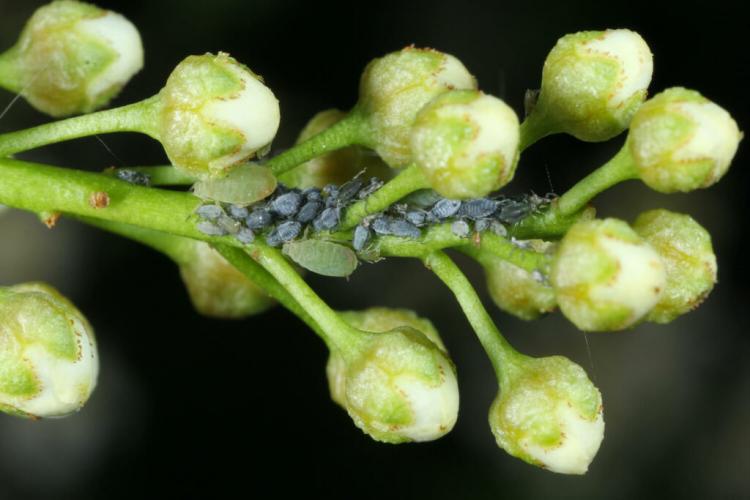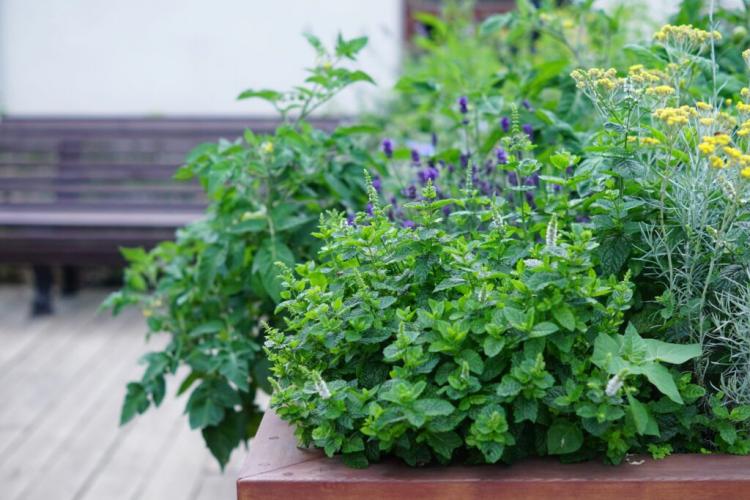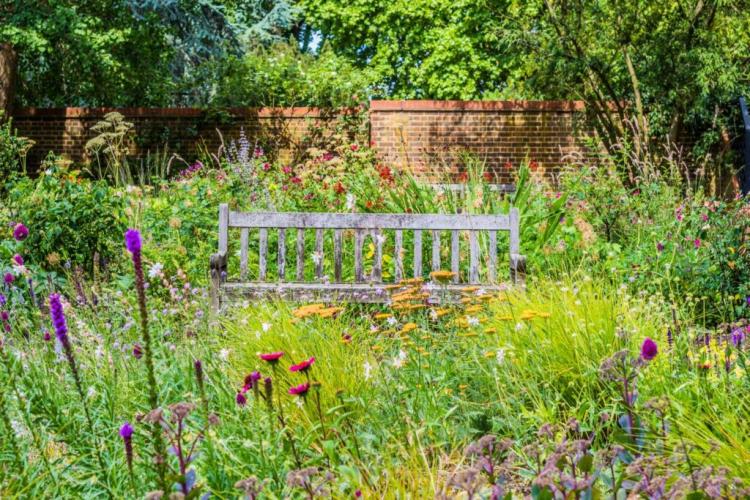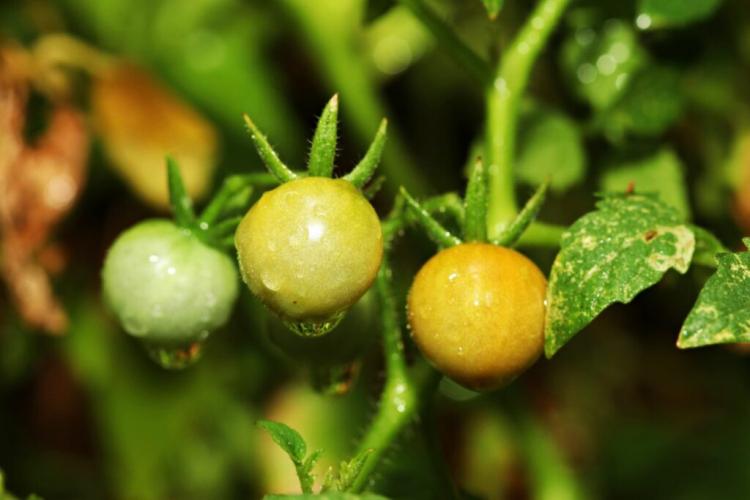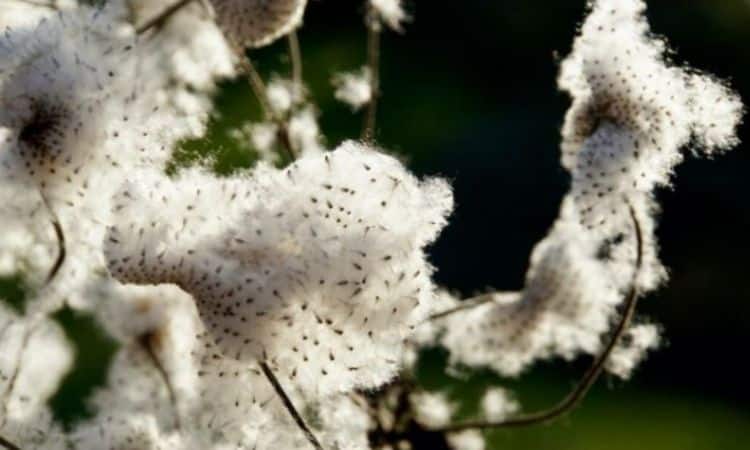Blood Plum: Fruits, Plants And Care Of The Ornamental Plum
The blood plum tree (also called ornamental plum) impresses not only with its appearance but also with its delicious fruits. We reveal how to properly plant the blood plum and what to consider when cutting and fertilizing.
The blood plum ( Prunus cerasifera ˈNigraˈ) owes its name to the characteristic reddish color of its leaves. In addition to the pretty red foliage, the bright pink flowers give the wood a special ornamental value.
Blood plum: flowering time, origin and characteristics
Table of Contents
The blood plum is a type of cherry plum ( Prunus cerasifera ), the foliage of which appears in a metallic, shiny, dark shade of red. It originally comes from the Middle East. The early flowering ornamental tree is not only found in gardens and parks, but you can also often find it overgrown in the wild as orchards and hedges at the edges of roads and fields. The blood plum grows as a large shrub or as a small to medium-high tree and reaches heights of 5 to 7 meters. The trunk has a blackish-colored bark.
Older shoots have a dark brown-red, shiny bark and are usually covered with fine thorns. Annual shoots are brown-red in color. Before the leaves shoot, the delicate, 2 to 3 centimeters large flowers of the blood plum appear from mid-March. These are composed of five radially arranged petals. They are pale pink in color and surround the stamens, which are also pink.
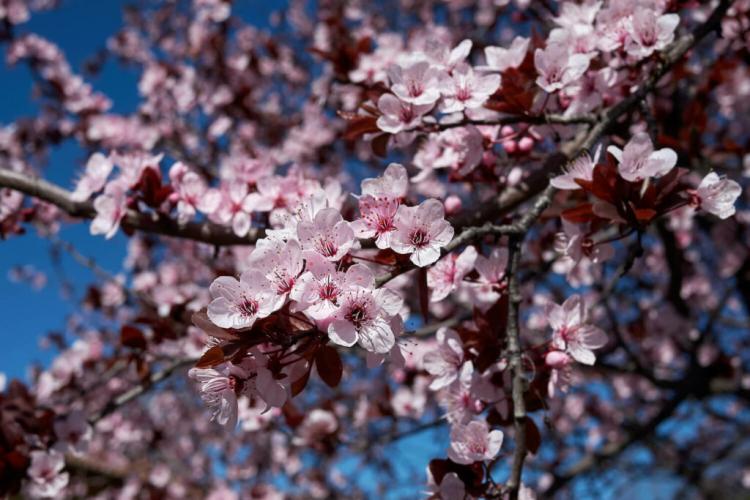
The deciduous leaves develop from April. They are about 5 centimeters long, have an elliptical shape, and become a little darker in the course of the growing season. In late April to early May, juicy, sweet plums form after flowering. The 2 to 3 centimeters thick cherry plums are ripe for harvest from July.
Blood plum varieties
The most common blood plum variety is Prunus cerasifera ‘Nigra’. This variety was introduced in the United States around 1916. It grows as a large shrub, but can also be grown as a tree with a trunk. It reaches a height of 3 – 4 meters and a width of 2 – 5 meters. The dark red, glossy leaves, and pink flowers are characteristic.
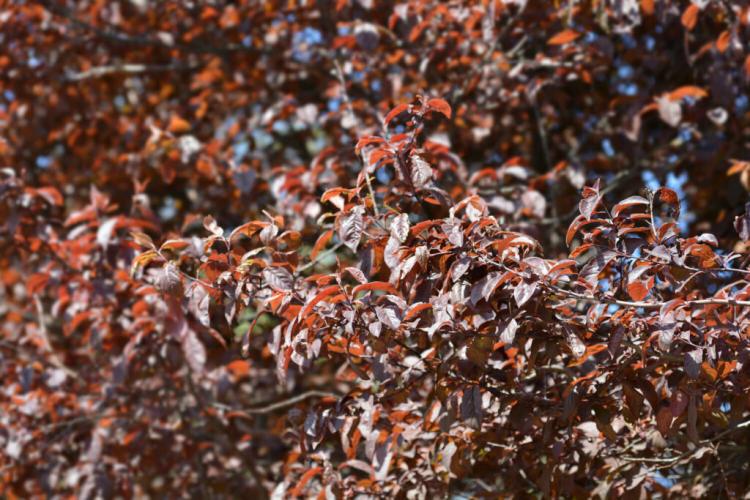
Another blood plum variety is Prunus cerasifera ‘Woodii’. Visually, it can hardly be distinguished from the ‘Nigra’ variety.
The variety Prunus cerasifera ‘Hollywood’, also known to us under the variety name ‘Trailblazer’, also grows as a loosely branched shrub. It becomes 3 – 7 meters high and 1 – 2.5 meters wide. Its fruits are slightly larger than those of the aforementioned varieties, which is why it is also known as the “large-fruited blood plum”.
Blood plum as a high stem
The above-mentioned blood plum varieties can also be raised as high stems and are also offered as such in specialist plant shops. In this growth form, the blood plum can be wonderfully planted alone in the garden.
Dwarf blood plum
As the name suggests, the dwarf blood plum Prunus x cistena is characterized by a lower growth height (1.5 – 2.5 meters) compared to other blood plum varieties. The slow-growing variety is considered the original species and opens its numerous pink-white flowers between the end of April and May.
Pillar plum
The blood plum variety Prunus cerasifera ‘Crimson Pointe’® is known as a columnar blood plum because of its upright, columnar growth. It reaches heights of 3 – 5 meters but is only 1 – 1.8 meters wide.
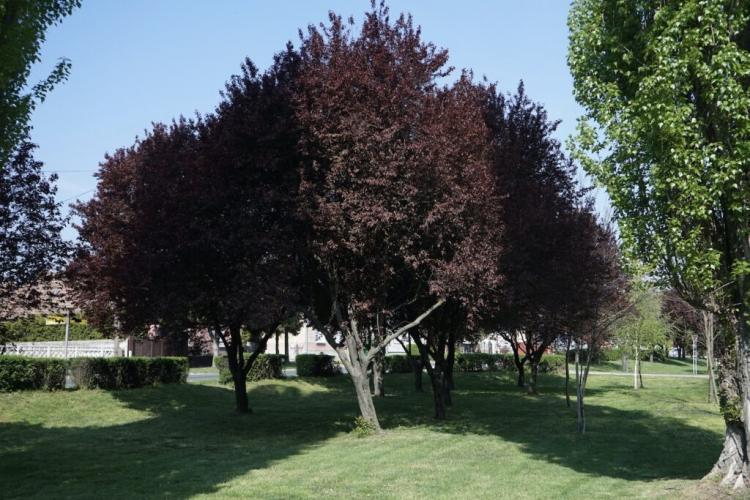
Planting blood plum: location and procedure
Blood plums are very robust and undemanding plants. The perfect location for the blood plum is full sun to shady and warm. The ornamental wood also thrives in partially shaded or shady places, but usually forms fewer flowers. The soil should be moderately dry to moist, rich in nutrients, and have a high proportion of clay and a neutral to alkaline soil reaction. The wood will thrive on most garden soils. If the blood plum has grown successfully and has established itself well in its location, it will survive dry summer months without damage.
The right time to plant a blood plum is autumn or spring. When the right location in the garden is found, you dig a planting hole that should be about twice the size of the plant container or the bale. It is filled with a little loosened garden soil or potting soil. Here, for example, our peat-free Gardender organic universal soil is very suitable.
You might like: Pruning plum trees: when and how is it pruned?
Due to the high proportion of compost and organic fertilization, it offers optimal starting conditions for good long-term plant development. In the case of container plants, the roots should be slightly scratched before planting. The resulting injuries stimulate their branching. Then you put the plant ball in the planting hole, fill it with the substrate, and water it properly.
Tip: Large blood plums or trees raised as high trunks should be attached to at least one, preferably two, wooden stakes with a stable tree connection. Without a connection, the young trees have little hold and cannot grow well because the newly emerging fine roots are torn off again and again with every movement above ground. However, this measure is not necessary for small container plants.
The blood plum can also be planted in a tub for the balcony or terrace. However, only the dwarf blood plum with its comparatively low growth height is suitable for this. When choosing a pot, make sure that it is sufficiently large (at least 40 liters) and has a drainage hole. With an additional drainage layer made of pottery shards, waterlogging can be reliably avoided. Either garden soil or potting soil is suitable as a substrate. It has a good structure and contains all the important nutrients for healthy plant development.
Maintaining the blood plum
Overall, the blood plum is a very robust and undemanding wood. In addition to occasional fertilization and watering of young blood plums, pruning measures can be carried out if desired. Further maintenance measures are usually not necessary.
Fertilize and water blood plum
As an undemanding ornamental wood, the blood plum does not need regular fertilization. Fertilization with horn shavings, compost, or the use of high-quality potting soil for planting provides an ideal condition for vigorous growth. To maintain the nutrient content of the soil, compost fertilization can also be carried out in the spring from time to time.
Occasional fertilization is advisable for blood plums in the tub. Because compost is rather unwieldy here, an organic complete fertilizer can be used. Mineral fertilization should be avoided, especially with potted plants: In the long term, it ensures that the soil or substrate collapses and plant growth deteriorates due to the resulting lack of oxygen at the roots.
You might so like: Cherry Plum: Everything About The Rote Mirabelle
Sufficient water supply is particularly important immediately after planting so that the young plant can grow well. Older blood plums usually do not need to be watered. Even longer dry periods in the summer months usually do not damage the developed blood plums.
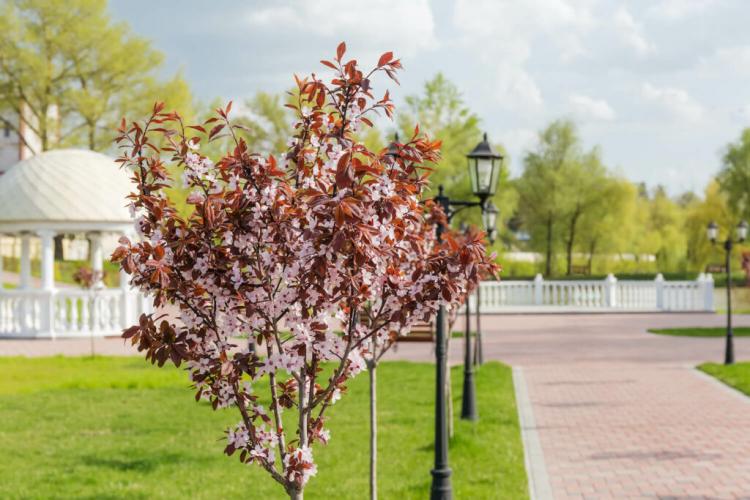
Cut blood plum
The blood plum does not have to be cut back regularly. Occasional pruning, however, promotes flowering. If necessary, the shape of the crown can also be changed by cutting measures and the blood plum can also be raised as a half or high trunk. In older blood plums, the crown can be thinned out if it grows too dense.
Here, the tips are not shortened, but rather entire branches are removed. Make sure that you cut on cones: This means that when you remove a shoot or branch, you always leave stumps about 5 cm long, the cones. This measure is important because trees of the genus Prunus rarely close their wounds by overburdening them, i.e. by forming wound tissue (callus), but simply drying them back on the affected areas.
Tip: The blood plum is a hardy plant. Only in rough locations should the trunks of young trees be coated with lime or coated with lime in winter, as their young bark is prone to frost cracks.
Propagate blood plum
Blood plums can be propagated from seeds or cuttings. Growing from seeds is a very time-consuming affair, while cherry plum cuttings rarely get through.
Fortunately, it is possible to refine the blood plum. The best method for grafting the blood plum would be copulation. The vines are cut in winter until around the end of January. These should be stored in a cool and dark place until they are processed between March and April.
You might so like: Plum tree plants: instructions and tips for care
Blood plum fruits: edible or poisonous?
The fruits of the blood plum are edible. Only the seeds contained in the core are poisonous. Therefore, one should not swallow the kernels. The ripe cherry plums can be eaten raw and have a sweet taste. They can be wonderfully processed into aromatic jams or cakes.
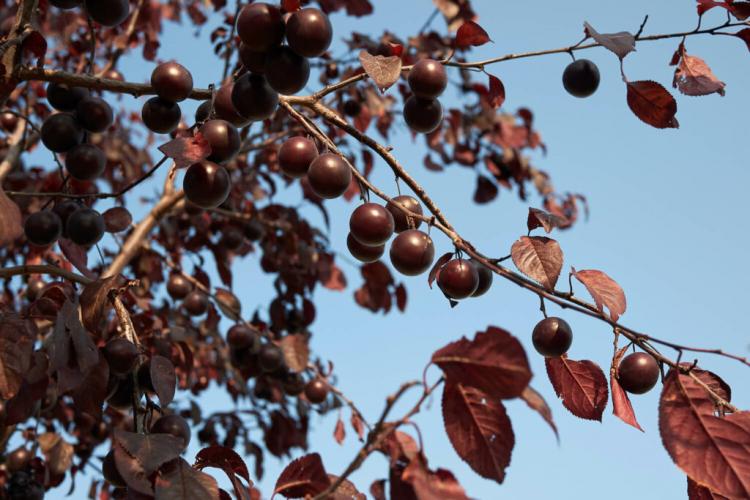
Blood plum harvest: when are they ripe?
Fruiting begins at the beginning of May at the latest when the flowers have faded. About two months later (from the beginning of July) the fruits are ripe and can be harvested.
The approximately 3 cm large plums turn cherry-colored, deep red to purple when ripe. The fruits give in slightly at the touch of a finger, become softer, and thus ring in the harvest time for the blood plum.
Blood plum: diseases and pests
Diseases that are relevant for the blood plum, but usually not life-threatening, are powdery mildew, monilia (tip drought and fruit rot), and shotgun disease. These are fungal diseases that often occur in fruit trees. The pests that attack the blood plum are essentially the aphid and the small frost worm.
As a rule, large blood plums are rarely impressed by fungal diseases. In young plants, however, the affected foliage should be removed to prevent it from spreading. In the case of young plants, a change of location can also be considered if it is suspected that an unsuitable location has promoted the disease. In addition, a sufficient supply of potassium and calcium can prevent fungal diseases. With its long-term effect and its balanced NPK ratio, it promotes the maintenance of healthy, vital plants. Occasional liming or spreading eggshells as fertilizer is also beneficial for the health of the blood plum.
You might so like: Mirabelle Plum Tree: Everything about planting, cutting, and harvesting
A moderate aphid infestation usually does not need to be controlled. Having ladybugs in your garden will reduce the infestation. If you have massive problems with aphids on your cherry plum, please see our aphid control article for help.
